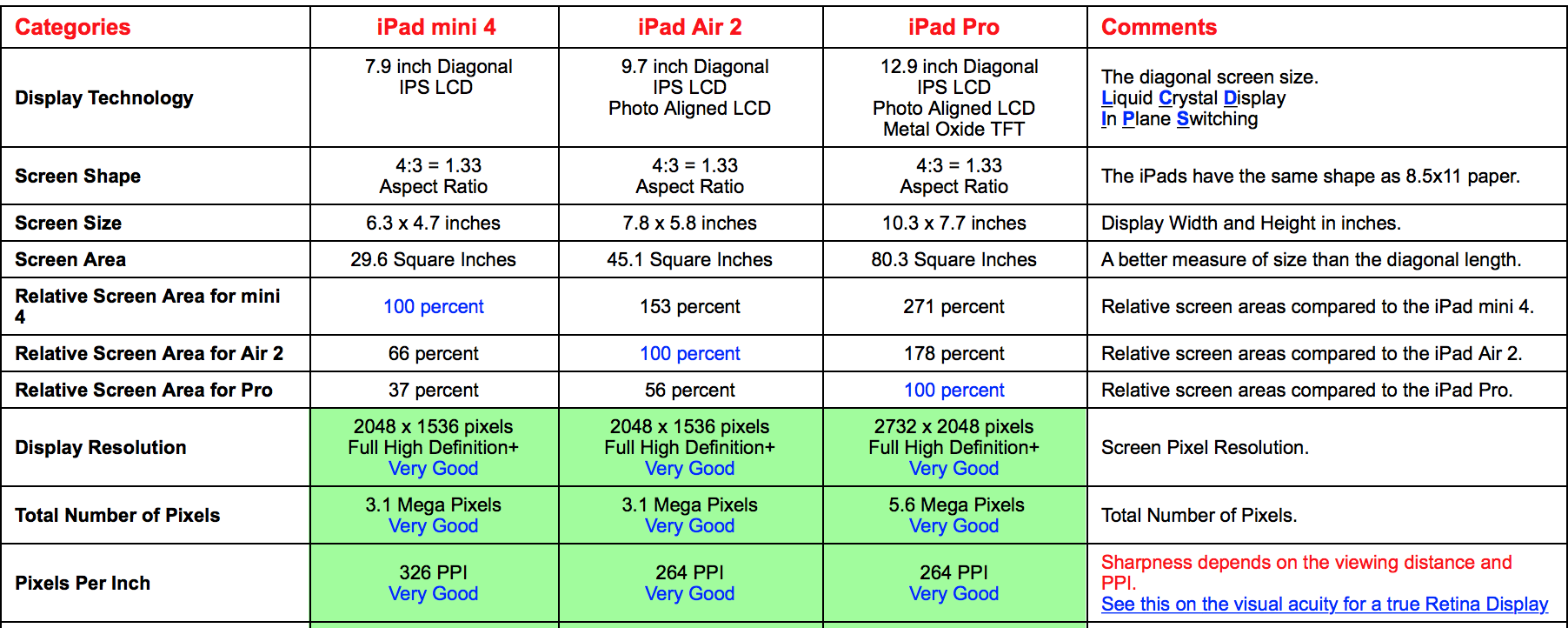An example statement they make is,
we examine in-depth the LCD displays on the Apple iPad mini 4, the iPad Air 2, and iPad Pro based on objective Lab measurement data and criteria.Lab measurements! They sure put a lot of work into getting everything right. Didn't they?
But people suck at dealing with details. They may well have tried hard, but they have presented false information as if it were a fact. Here's the relevant part of their fact chart:

What caught my attention was the claim that iPad Air 2 is 7.8 inches tall while iPad Pro is 7.7 inches wide. I remembered Apple saying the Air's height and Pro's width matched during a presentation about new multitasking features. (As I remember it, Apple basically said you can fit a whole iPad Air on the pro screen and then have an area left over to the side for a second app.)
So I thought, huh, Apple fudged it. I thought they'd present an exact match here, but actually it's just pretty close.
But then I noticed the number of pixels does exactly match. The Air is 2048 pixels tall. The pro is 2048 pixels wide.
And the Pixels Per Inch exactly matches too at 264.
But if you have the same number of pixels, and the same number of pixels per inch, then the number of inches should also match. The chart contradicts itself.
So how many inches is it? Assuming the pixels and pixels per inch are correct then it's: 2048/264.0 = 7.757575 repeating.
So the actual value is between the 7.7 and 7.8 inches given, and a little closer to 7.8. Both numbers should have been rounded up to 7.8 inches since that's closer.
I wouldn't mind so much if both numbers were rounded the same direction, either way. But getting the same number in two adjacent boxes on your chart, and then rounding one up and the other down, is really not OK. This is a factual error caused by a methodology error. Whatever one's policy for rounding numbers, the same policy should be used for the entire article.
I emailed the article author and will update this post if it's fixed. The article did invite comment. As usual, I understand that mistakes can happen. We'll see if he's willing to fix it. Willingness to fix mistakes, or not, is even more important than making mistakes, or not, in the first place.
Update 2015-12-03:
They replied:
You have incorrectly assumed that both displays have exactly the same 264.0 ppi in order to calculate their width and height. This is a technically weak assumption.So they did it by assumption, not lab measurement. And they did the calculation using Apple's tenths of diagonal inches number as exact, even though it's easy to guess that's rounded. Basing their numbers directly on Apple's rounded tenths of diagonal inches is not a reasonable way to end up publishing that two things which are basically the same length are a tenth of an inch apart.
We used the published screen size to calculate the width and height. Both methods are subject to a round off error of the Apple published specifications, but ours is the more technically sound one because it only assumes that the displays have square pixels, which is true for all current high-end displays to very high precision.
A 2732x2048 pixel 12.9" screen is 7.74" by 10.32" which is 7.7 x 10.3 as published
A 2048x1536 pixel 9.7" screen is 7.76" by 5.82" which is 7.8 x 5.8 as published
The 264 PPI number from Apple is also rounded, but it could still easily be that the displays Apple gives the same PPI number for are actually made in the same way and have the same PPI. PPI is not something Apple would want to manufacture in lots of slightly different variants, they'd prefer reuse. (If Apple was fine with slightly different PPIs, you'd often see PPI numbers that are a couple apart, rather than different by at most a rounding error, but you don't see that in Apple's lineup.)
So I still think DisplayMates are mistaken and their article is unreasonable. And I think it's bad to publish seemingly contradictory numbers without saying the methodology you used so that readers can judge for themselves if it's reasonable. And they've refused to change this.
Messages